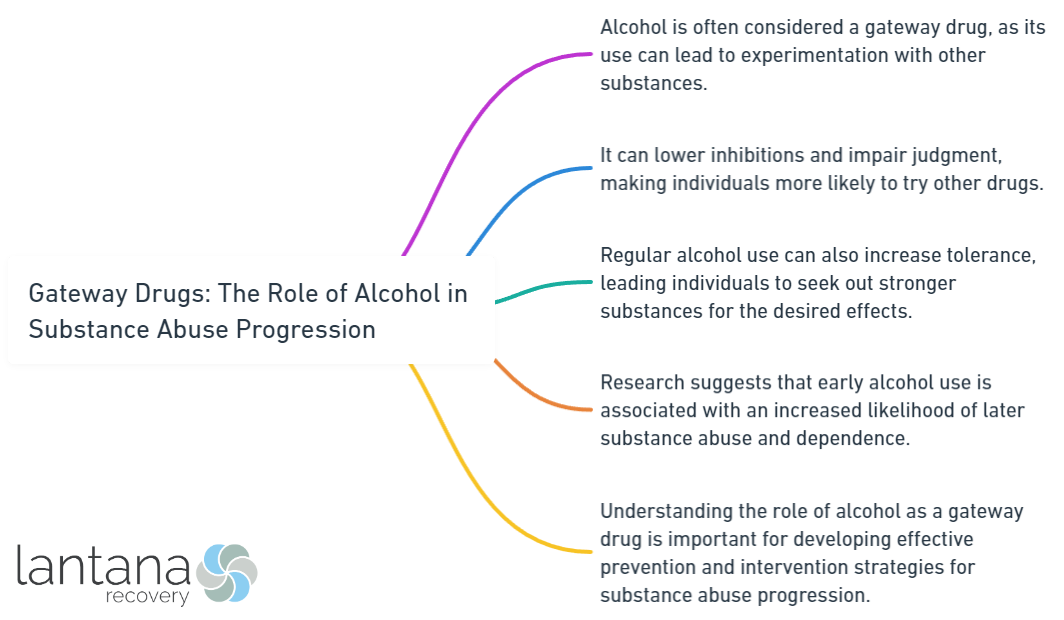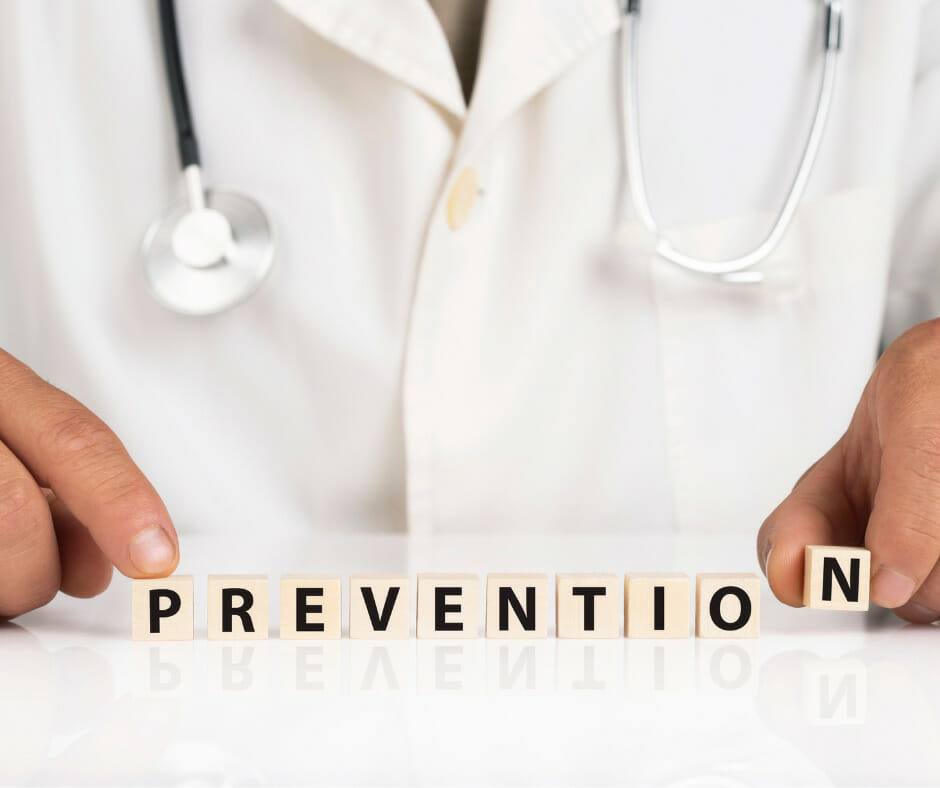Gateway drugs are substances that are thought to increase the risk of progressing to the use of more dangerous and addictive substances. They are often the first drugs that individuals experiment with before moving on to harder drugs. Alcohol is one such gateway drug that plays a significant role in substance abuse progression.
Alcohol is commonly recognized as a gateway drug due to its widespread availability and social acceptance. It serves as an entry point for many individuals into the world of substance use. The consumption of alcohol can lead to changes in brain chemistry and decision-making, making individuals more susceptible to trying other drugs.
Alcohol’s impact on brain chemistry is a key factor in the progression to other substances. It affects the reward and pleasure centers of the brain, creating a heightened sense of euphoria and relaxation. This reinforcement can lead individuals to seek similar experiences through the use of other drugs.
Alcohol can impair judgment and decision-making abilities. This lowered inhibitory control can increase the likelihood of experimenting with drugs that individuals may have otherwise avoided. The combination of altered brain chemistry and impaired decision-making creates an environment conducive to substance abuse progression.
Several factors contribute to the risk of progression from alcohol to other drugs. Genetic predisposition plays a role, as individuals with a family history of substance abuse may be more susceptible to substance use disorders. Environmental influences, such as living in areas with easy access to drugs or growing up in households where substance use is prevalent, can also increase the risk. Peer pressure and the desire to fit in with social circles that engage in substance use can further drive progression.
To address the issue of substance abuse progression, prevention strategies are essential. Educational programs and awareness campaigns can provide information about the dangers of gateway drugs, including alcohol, and help individuals make informed decisions. Early intervention and treatment programs can also play a crucial role in mitigating the progression to more dangerous substances by addressing underlying risk factors and providing support to individuals at risk.
Understanding the role of alcohol as a gateway drug and the factors that contribute to substance abuse progression is vital in developing effective prevention and intervention strategies. By addressing these issues, we can work towards reducing the prevalence and impact of substance abuse in society.

What Are Gateway Drugs?
Ever wondered what exactly are gateway drugs? In this section, we’ll uncover the truth behind these substances and their role in drug abuse progression. From defining what gateway drugs really are to exploring some compelling examples, get ready to delve into a world where innocent experimentation can lead down a dangerous path. So buckle up and let’s uncover the hidden connections between these substances and their impact on substance abuse.
Definition of Gateway Drugs
Gateway drugs, such as alcohol, tobacco, and marijuana, are substances that can lead to the use of more dangerous and addictive drugs. Unlike medication like Busiprone, these substances serve as an initial introduction to substance abuse, altering brain chemistry and increasing the risk of addiction. Alcohol, in particular, is a common gateway drug due to its widespread use and social acceptance. While it is often used for relaxation or social interaction, regular and excessive consumption can increase the likelihood of trying other drugs.
Gateway drugs, like alcohol, stimulate the release of dopamine, a neurotransmitter associated with pleasure and reward. This release of dopamine reinforces the desire to seek out substances that produce similar effects, potentially leading to the use of more dangerous drugs. Additionally, the impairment of decision-making abilities caused by alcohol makes individuals more susceptible to trying other drugs in search of heightened pleasure or escape from negative emotions.
Several factors, including genetics, environment, and peer pressure, contribute to the risk of progressing from gateway drug use to more serious substance abuse. To prevent this progression, education programs and awareness campaigns are vital. Early intervention and treatment are also crucial in identifying and addressing potential issues before they worsen. By understanding the definition of gateway drugs and their risks, individuals can make informed decisions and seek the necessary support to maintain a healthy and drug-free lifestyle.
Examples of Gateway Drugs
When it comes to gateway drugs, it’s important to know that they can lead to the use of more dangerous and addictive drugs. Here are some common examples:
1. Marijuana: It can lead to trying other substances due to its effects on the brain.
2. Alcohol: Impairs judgment and decision-making, increasing the likelihood of trying other substances.
3. Tobacco: It may not be highly addictive itself, but it can be a gateway to nicotine addiction, which can then lead to other substances.
4. Prescription drugs: Misuse or abuse of prescription drugs, like opioids or benzodiazepines, can lead to illegal drug use. They can create a dependence that may lead individuals to seek more potent substances.
5. Inhalants: Often used by young individuals as a form of experimentation, but can lead to addiction and the use of other drugs.
Not everyone who uses gateway drugs progresses to more dangerous substances. However, their use increases the risk of substance abuse and addiction.

The Role of Alcohol in Substance Abuse Progression
The Role of Alcohol in Substance Abuse Progression acts as a gateway drug and can worsen existing substance abuse problems. The addictive nature of alcohol, combined with its widespread use and social acceptance, increases the risk of individuals progressing to more harmful substances.
The role of alcohol in substance abuse progression is complex. It lowers inhibitions, impairs judgment, and increases impulsivity, making individuals more likely to try other substances. Additionally, alcohol is often used as a way to cope with psychological or emotional distress, leading people to turn to other substances for relief. Moreover, alcohol can affect the brain by increasing dopamine release and reinforcing addictive behaviors. This reinforcement can create a desire for stronger substances, leading to further substance abuse.
To address the role of alcohol in substance abuse progression, it is necessary to raise awareness and provide education on the dangers and consequences of excessive alcohol consumption. Implementing preventive measures, such as responsible alcohol advertising, stricter regulations, and accessible treatment options, is also crucial in reducing the impact of substance abuse.
By recognizing and addressing how alcohol plays a role in substance abuse progression, we can work towards prioritizing the well-being and health of individuals and minimizing the overall impact of substance abuse on communities.
Alcohol as a Common Gateway Drug
Alcohol, as a common gateway drug, plays a significant role in contributing to substance abuse. It is important to fully comprehend the impact that alcohol use has on individuals.
To begin with, alcohol serves as a gateway drug due to its accessibility and widespread societal acceptance. Many individuals are first introduced to alcohol at a young age, often through social gatherings or simply by experimenting. This initial exposure heightens the likelihood of later trying other illicit drugs.
Furthermore, alcohol directly affects the brain and influences decision-making processes, thus leading to substance abuse. It alters the chemistry of the brain, impacting neurotransmitters that regulate mood, behavior, and reward which can even result in paranoia. Consequently, the risk of developing substance use disorders and seeking out more potent substances is significantly increased.
Besides, genetic predisposition, environmental influences, and peer pressure also contribute to the likelihood of transitioning from alcohol to other drugs. Individuals with a family history of substance abuse are particularly vulnerable to addiction. Additionally, living in an environment that encourages substance abuse and facing peer pressure can greatly influence individuals to experiment with other drugs.
In order to prevent the progression from alcohol to substance abuse, educational programs and awareness initiatives are of utmost importance. These programs should provide accurate information about the risks and consequences associated with alcohol and drug use. Additionally, early intervention and treatment are crucial in promptly addressing issues related to substance abuse.
It is essential to remember that the most effective way to prevent the progression from alcohol to substance abuse is by making informed decisions and seeking support when necessary. Keeping oneself well-informed about the effects of alcohol and other drugs and prioritizing personal well-being are key.
How Does Alcohol Lead to Substance Abuse Progression?
Alcohol is a gateway drug that leads to substance abuse progression. Here’s how alcohol contributes to this progression:
1. Increases tolerance: Regular alcohol consumption develops tolerance, requiring higher amounts for desired effects. This increased tolerance may lead to experimentation with other substances for similar intoxication.
2. Impairs judgment and decision-making: Alcohol impairs cognitive functions like judgment and decision-making, leading to risky choices such as trying other drugs or engaging in dangerous behaviors associated with substance abuse.
3. Alters brain chemistry: Alcohol affects the brain’s reward system and neurotransmitters like dopamine, creating pleasurable experiences and reinforcing alcohol use or leading to seeking similar effects from other substances.
4. Peer influence: Alcohol use often occurs in social settings, where peers may pressure individuals to try other substances. This pressure increases the likelihood of trying other drugs and eventually developing substance abuse problems.
5. Genetic predisposition: Some individuals have a genetic predisposition to substance abuse. Alcohol use can trigger these genetic factors, making individuals more susceptible to experimenting and developing dependence on other substances.
It’s important to note that not everyone who drinks alcohol will progress to substance abuse. Factors such as genetics, environment, and personal choices play a role in determining an individual’s susceptibility to substance abuse progression.

The Connection Between Alcohol and Other Drugs
Unpacking the intertwining relationship between alcohol and other substances, we delve into the intriguing connection that exists. From the intricate dance of brain chemistry influenced by alcohol to the far-reaching impact on decision-making, this section uncovers the fascinating dynamics that fuel substance abuse progression. Get ready to explore how alcohol acts as a gateway, shedding light on the complex web of dependencies and the factors that contribute to their development.
Alcohol’s Influence on Brain Chemistry
Alcohol significantly influences brain chemistry and plays a crucial role in substance abuse progression.
1. Alcohol affects neurotransmitters in the brain: It depresses the central nervous system, slowing down brain activity. Alcohol primarily enhances the effects of the inhibitory neurotransmitter GABA and reduces the effects of the excitatory neurotransmitter glutamate. This leads to sedation, relaxation, and impaired cognitive function.
2. Alcohol disrupts brain communication: Chronic alcohol use disturbs normal communication between brain cells, affecting regions such as the prefrontal cortex (decision-making), the hippocampus (memory formation), and the amygdala (emotions). This disruption can result in difficulties with impulse control, memory impairment, and emotional instability.
3. Alcohol influences reward pathways: Alcohol stimulates the release of dopamine, a neurotransmitter associated with pleasure and reward. Regular alcohol consumption causes the brain to adapt to these increased dopamine levels. Over time, individuals may require higher amounts of alcohol to achieve the same pleasurable effects, leading to tolerance and potentially addiction.
4. Alcohol’s impact on brain development: The adolescent brain is particularly vulnerable to the effects of alcohol. Excessive alcohol consumption during this critical period can interfere with brain development, affecting cognitive abilities, decision-making skills, and increasing the risk of future substance abuse.
Understanding alcohol’s influence on brain chemistry is crucial in recognizing the potential risks and consequences of its consumption. By being aware of these effects, individuals can make informed decisions about alcohol use and take steps to prevent substance abuse progression.
Alcohol’s Impact on Decision-Making
Alcohol’s impact on decision-making is a significant concern. This substance impairs the brain’s ability to accurately assess consequences, particularly in the prefrontal cortex. This region is responsible for regulating impulses and enabling rational choices. When under the influence of alcohol, individuals are more prone to acting impulsively, often without considering the potentially negative outcomes.
Even moderate alcohol consumption has been shown to have a detrimental effect on decision-making. Research has highlighted that individuals who consume alcohol before engaging in risky activities, like driving, are more inclined to take greater risks compared to those who are sober.
It’s worth noting that the impact on decision-making becomes more pronounced with higher levels of alcohol consumption. Excessive drinking can lead to blackouts, causing individuals to have no memory of their actions. This reinforces the harmful effects that alcohol can have on decision-making.
Understanding the impact of alcohol on decision-making is vital, especially for individuals susceptible to substance abuse progression. By recognizing the potential consequences, individuals can make informed choices and actively seek support to prevent the escalation of substance abuse.

Factors that Increase the Risk of Progression
Understanding the factors that increase the risk of substance abuse progression is crucial in addressing addiction. In this section, we’ll dive into the key elements that contribute to this risk. From genetic predisposition to environmental influences and the relentless peer pressure, we’ll examine how these factors play a role in shaping the path towards substance abuse. So, buckle up as we unravel the intricate web of risks surrounding substance abuse progression.
Genetic Predisposition
Genetic predisposition plays a crucial role in determining the risk of substance abuse. Individuals who have a family history of addiction are more likely to develop substance abuse problems themselves. Approximately 40-60% of a person’s vulnerability to addiction can be attributed to genetic factors.
One specific gene that influences addiction risk is the dopamine D2 receptor gene (DRD2). If this gene’s function is altered, it can increase the likelihood of addiction. It is important to note that genetic predisposition does not guarantee addiction on its own, but it does make individuals more susceptible to specific environmental triggers, such as drugs or stressful life events.
It is crucial to consider that genetics should not be viewed in isolation. Environmental factors and personal choices also play significant roles in substance abuse. Nevertheless, understanding one’s genetic predisposition can be beneficial in making informed decisions and taking preventative measures. By acknowledging their genetic predisposition, individuals can gain a better understanding of their susceptibility to substance abuse and take proactive steps to reduce the associated risks.
Environmental Influences
Environmental influences play a significant role in the risk of substance abuse. These factors shape behavior and increase vulnerability to drug use. Being aware of these influences is important for preventing and addressing substance abuse.
1. Peer group: The people a person spends time with can strongly influence their drug use. If their social circle engages in substance abuse, there is a higher likelihood of experimenting and continuing drug use.
2. Family environment: The family plays a crucial role in shaping attitudes and behaviors. Growing up in an environment where substance abuse is prevalent increases the risk of developing substance abuse problems later in life.
3. Cultural norms: Cultural beliefs and societal norms surrounding drug use can influence behavior. In certain communities or social settings, drug use may be more accepted or even encouraged, leading to a higher likelihood of substance abuse.
4. Accessibility: Easy access to drugs or alcohol can significantly impact substance abuse. If substances are readily available in the community or household, the risk of experimenting and regular use increases.
5. Traumatic experiences: Exposure to violence, abuse, or other traumatic experiences can contribute to substance abuse as a way to cope with emotional pain or trauma.
Pro-tip: Building a strong support network, surrounding oneself with positive influences, and seeking professional help when needed can help mitigate the negative impact of environmental influences and reduce the risk of substance abuse.
Peer Pressure
Peer pressure is an influential factor when it comes to substance abuse. A person may try drugs or alcohol in order to fit in or gain acceptance from their peers.
“Much research (mostly from general population surveys) suggests that people typically use alcohol, tobacco and then marijuana, so called ‘gateway drugs’, prior to any potential use of ‘hard drugs’ like cocaine powder, crack and heroin” (The misuse of the “Gateway Theory”, Golub & Johnson, 2002.) It is crucial to understand the impact of peer pressure and to resist negative influences.
Peer pressure can have a significant impact on an individual’s decision to experiment with gateway drugs like alcohol. Peers may actively encourage substance use, making it appear socially acceptable or even desirable. The desire to fit in with one’s peers can override an individual’s ability to make wise judgments, leading to risky behaviors.
The fear of being excluded can also drive individuals to participate in substance use, despite any reservations they may have. In social situations where substance use is common, peer pressure can be especially intense.
To resist negative peer pressure and make informed decisions, it is important to cultivate personal values and self-confidence. Educational programs and awareness campaigns are valuable tools that provide individuals with strategies to resist peer pressure.
In addition, developing a supportive network of friends who share similar values and goals can be instrumental in resisting negative peer pressure and making healthier choices. By being aware of the influence of peer pressure and taking proactive measures, individuals can decrease their risk of substance abuse and prioritize their own well-being and values.

Prevention Strategies
Prevention is always better than cure! In this section, we’ll uncover effective strategies to combat substance abuse progression through educational programs, awareness campaigns, early intervention, and treatment options. With staggering statistics and real-life stories, we’ll explore how these interventions play a vital role in curbing the influence of gateway drugs like alcohol. Buckle up for insightful information and empowering strategies to create a healthier, substance-free future. Let’s dive in and make a difference!
Educational Programs and Awareness
Educational programs and awareness are essential in preventing substance abuse and addiction. These programs play a crucial role in equipping individuals with the knowledge needed to make informed decisions about drug use. Here are some key points to highlight the significance of these programs:
- Information dissemination: Educational programs provide accurate and up-to-date information about the risks and consequences of drug abuse. They aim to educate individuals about the detrimental effects drugs have on physical and mental health, relationships, education, and overall well-being.
- Early prevention: These programs specifically target young people, empowering them to make healthier choices and avoid substance abuse during adolescence – a critical time for experimentation.
- Signs and symptoms: Educational programs teach individuals to recognize the signs of substance abuse in themselves or others, enabling early detection and intervention for appropriate help and support.
- Resisting peer pressure: An important aspect of these programs is building skills to resist peer pressure. By teaching refusal strategies and assertiveness, individuals are equipped to confidently say no to situations involving drug use.
- Community involvement: Educational programs involve community outreach and engagement. They raise awareness, provide resources, and foster a supportive environment to proactively address substance abuse.
Educational programs and awareness campaigns are crucial in comprehensive substance abuse prevention. By providing knowledge, skills, and support, these initiatives contribute to building a healthier and drug-free society.
Early Intervention and Treatment
Early intervention and treatment are crucial for addressing substance abuse and preventing its progression. By promptly identifying and addressing the issue, individuals have a better chance of overcoming addiction and minimizing its negative impact.
One effective approach to early intervention is educational programs and awareness campaigns. These initiatives provide information about the dangers of substance abuse, signs of addiction, and available treatments. They equip individuals with knowledge and resources to seek help at the earliest stages of addiction.
Another essential aspect of early intervention is accessible and timely treatment services. This includes counseling, therapy, and support groups designed for individuals struggling with substance abuse. These interventions aim to address underlying issues, enhance coping skills, and promote a sustainable recovery process.
Moreover, it is important to tailor early intervention and treatment to each individual’s needs. Personalized approaches from institutions like Lantana Recovery yield the best outcomes due to the diverse nature of addiction. By offering evidence-based treatments such as cognitive-behavioral therapy and medication-assisted treatment, individuals can receive the necessary tools to break free from addiction.
It is worth noting that early intervention and treatment are not limited to the individuals directly affected by substance or drug abuse. Friends, family, and communities also play a vital role in providing support and encouraging individuals to seek help. By creating a supportive and understanding environment, the chances of successful intervention and long-term recovery are significantly boosted.
Frequently Asked Questions
What is the Gateway Drug Theory?
The Gateway Drug Theory suggests that teen substance abuse starts with alcohol and tobacco and then progresses to more addictive drugs.
What research has been done on teen substance abuse?
Underage drinking is common, with nearly one-fourth of teens aged 14 to 15 having at least one drink in a year.
Who originated the Gateway Drug Theory?
The Gateway Drug Theory originated from studies conducted in the 1970s, which showed a specific sequence of teenage drug use starting with alcohol and cigarettes and progressing to substances like marijuana, cocaine, and heroin in adulthood. Denise Kandel is credited with developing the theory.
What evidence supports the Gateway Drug Theory?
Recent studies have provided evidence supporting the Gateway Drug Theory. One study found that the majority of participants who used multiple substances tried alcohol before tobacco or marijuana. Another study showed that using alcohol at age 15 increases the risk of injecting drugs in adulthood.
Are there other substances considered gateway drugs?
Yes, other substances such as marijuana, nicotine, and prescription pills are also considered gateway drugs.
Are there factors other than gateway drugs that contribute to substance abuse?
Yes, other factors such as teens’ attitudes toward drugs, environmental factors, genetics, and peer relationships also play a role in substance abuse.









